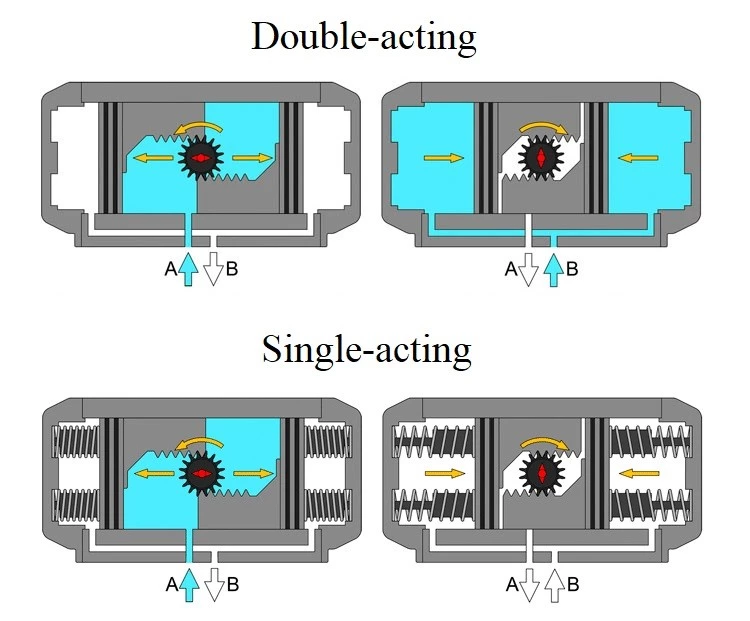There are two categories of actuators: double-action and single-action.
A control valve that is single-action is one that has one side that is moved by a spring or membrane and is driven by the air output of the control valve positioner on one side (open or uncontrolled).
A double action control valve is one that has its sides open and unrestrained and is controlled on both sides by the control valve positioner's output air.
The spring return, or single-acting, actuator and the double-acting actuator are the two actuators typically employed in ball, control, and choke valve operations.
The spring return actuator is an actuator that opens or leaves a valve in its unrestricted state by applying spring force. The valve can only be opened by applying pressure on one side of it.
The valve is operated by the double-acting actuator, which uses a piston as its element. To open the valve, we must alternately apply pressure to both sides of the selector.
Torque or Thrust Strength
Oil and gas operations along the coast are generally unaffected by the thrust or torque strength of the spring return and double-acting actuator.
Granted that some manufacturers claim that double-acting actuators are more advanced in terms of thrust or torque strength than spring return actuators, this distinction is limited to extremely high thrust or torque activities, which are rarely found in coastal applications. Thus, the thrust or torque strength of each is the same.
Safety Integrated System Application
In high-security system applications where the valve must remain open or unhindered in the event of a signal or supply loss, such as blow-down valves (BDV) and shutdown valves (SDV), the spring return is the recommended choice.
Because of its dependability and simplicity, the spring return type is the greatest option for safety operations. Although the initial panel configuration for double-acting actuators will be more complicated than that of spring return types, they are still an option for fail-close or open applications.
Fail in Last Position
Certain procedures, like the product choke valve, require the valve to be in the ultimate position when the signal or supply is lost. The default failure position of the choke valve is to fail last in order to preserve the prior output rate.
A double-acting actuator is the ideal choice if the last position is needed in the case of a failure. By applying pressure on both sides of the actuator, the valve is kept in place.
Control operation
For tiny valves up to 8 inches, the common actuator in a process control operation that uses a control valve as its ultimate control element is a diaphragm spring return diaphragm. To overcome the necessary high thrust, a double-acting type actuator is used when it is 10 inches or larger.
Even if the size is smaller than 10 inches, the double-acting actuator is still used when a substantial amount of push is needed to complete the action. For control operations, this double-acting actuator is stiffer and more stable, especially in situations where the process condition varies suddenly.
The thrust on the opposite side is always the same as the spring when using the diaphragm spring return type. A double-acting actuator allows the positioner pressure output to be adjusted.
The thrust on the opposite side is always the same as the spring when using the diaphragm spring return type. The positioner pressure output controls the opposite side forces based on the factual conditions when a double-acting actuator is used.
Choosing the Right Actuator for Your Application
Regarding torque or thrust strength, although some sources claim that the thrust and torque strength capabilities of both kinds of actuators are the same, we advise carefully examining your needs before making a snap decision. The spring actuator works well in situations where the torque load is experienced on a single side throughout the activation stroke due to its design. In contrast, large torque loads in both of its operating directions and enhanced thrust strength—like in many oil and natural gas operations—make the double-acting actuator function very well.
It's usually preferable to go with the simplest solution when requesting safety guarantees about safety system operations when proximity in shutdowns and fail-strongboxes is of the utmost concern. This implies that due of its durability and convenience of design, the spring return selector should be employed.
A valve must fall to the former post when it loses its signal or supply in a number of situations where the valve must fail in the last position. Because double-acting actuation uses pressurization on both sizes to maintain the valve safe and secure in the last position, it performs best for these tasks.
Conclusion
The performance of mechanical systems is greatly impacted by the decision made in automation and engineering between single-acting and double-acting actuators. Double-acting actuators provide precision and diversity for bi-directional operations at a somewhat higher cost than single-acting actuators, which are more economical and appropriate for one-way tasks. Selecting the appropriate choice ultimately affects automation system performance and cost-effectiveness and is dependent on unique requirements, budget, and task complexity.

